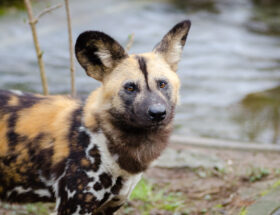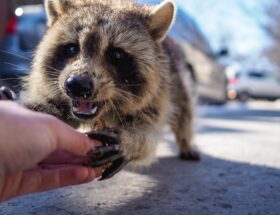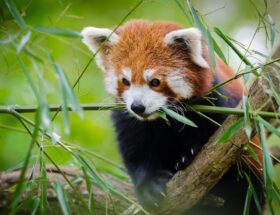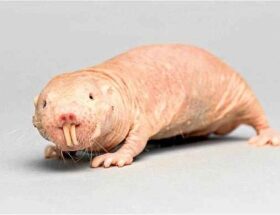Learn facts about the emperor penguin. This Antarctic bird is the only animal left in the open ice during winter. Learn about their amazing adaptations and their journey.
Quick and Easy Navigation
Emperor Penguin Physical Description
The incredible emperor penguin is a large flightless bird native to Antarctica. It is the tallest and heaviest of all penguin species. It is easily recognized because of its size, its black and white bodies, black wings, and orange-yellow colorings on the head, neck and breast. These penguins spend their entire life in the continent of Antarctica where temperatures can drop to as low as -76°F.
Emperor Penguin Habitat and Adaptations
The most amazing feature about this bird is its survival adaptations. Not only are they physically equipped to survive the frigid cold, but they also employ cooperative behaviors to help each other out. Emperor penguins have large stores of body fat for insulation and several layers of scale-like feathers to protect them from the cold and icy winds. They huddle together in large groups to keep each other warm. Taking turns moving towards the center of the group where it is warmer. While in a huddle, they continue to rotate to ensure all penguins get a turn to move further into the huddle where it is warmer. These birds spend the entire winter in the open ice and they are the only animal that spends the winter there.
Emperor Penguin Reproduction and Parenting
In Antarctica, the winter starts in April. This is when penguins meet in the thick Antarctic ice to find a mate. Some pairs find each other among thousands the following year. Others find a new mate for the season. Females lay an egg around June and immediately pass the egg on to the males and take off to look for food. They may travel up to 50 miles to reach the open ocean to search for food such as fish, squid and Krill. Once they have a full belly, they begin their journey back. The long trip can take up to 2 months. This is perfect timing as the egg incubates for those two months.
In the meantime, the father has been keeping the egg warm by balancing it on his feet underneath feathered skin called a brood pouch. By the end of those 2 long, cold months, the male penguin will lose up to 26lbs of body weight. This is because they take their fatherly duties very seriously and do not eat during that time. When the females return to the breeding site, they bring a belly full of food they regurgitate for the newly hatched chicks. The hungry male penguins start their journey to the open sea to find food for themselves.
Emperor penguin chicks are typically covered with silver-grey down, have black heads, and white masks. Mother penguins protect and keep their chicks warm under their own brood pouches. A young chick could die in minutes outside of the warm pouch. By December, the Antarctic Summer begins and the ice begins to break giving the penguins access to the ocean below. By now the young penguins are ready to swim and fish on their own.
Emperor Penguins Yearly Jouney
14 Interesting Facts About The Emperor Penguin | Size, Habitat, Diet & Facts
- The emperor penguins live on the ice shelves and landfast ice along the coastline of Antarctica.
- The emperor penguin is one out of 18 species of penguins.
- Their scientific name is Aptenodytes forsteri.
- They are about 45 inches tall and weigh up to 88 pounds.
- Their average lifespan is 15 to 20 years.
- A group of emperor penguins is called a colony.
- Emperor penguins are the world’s deepest-diving birds. They can reach depths of approximately 1,800 feet when searching for food.
- They can stay underwater for more than 20 minutes.
- Their aerodynamic bodies allow them to swim at speeds of up to 12 MPH.
- The emperor penguin breeds in the coldest environment of any bird species.
- Emperor penguin’s average body temperature is 102° F, and yet they live in an environment with air temperatures of -40° F, wind speeds of 89 MPH, and water temperatures of 28° F.
- They are carnivores and unlike other penguins which feed on surface krill, the emperor penguin dives deep to catch fish, squid, and crustaceans.
- During the months of January to March, the emperor penguins disperse into the oceans in groups foraging for food.
- April 25th is World’s Penguin Day. This date coincides with the annual northward migration of the Adelie penguins native to Antarctica.
Emperor Penguin Facts Video
Emperor Penguin Conservation Status
The emperor penguin is currently listed in the IUCN Red Lis of threatened species as near threatened. In addition, their populations are expected to decline rapidly in the coming years. Sadly, their natural habitat is severely affected by global warming. Rising temperatures are reducing the breeding grounds. Also, overfishing is decreasing the availability of food left behind for them to catch.
There is something we can all do. Live more sustainably and become conscious consumers. Take a look at the list of easy lifestyle changes you can implement today to live more sustainably, help the planet and all wildlife.
Also, reducing air pollutants and single-use plastic is a great way to help our planet, wildlife, and your health. Take a look at these easy ways to switch to DIY Homemade cleaning products.
Best Emperor Penguins Documentaries
My list of favorites:
March of the Penguins – In the Antarctic, every March since the beginning of time, the quest begins to find the perfect mate and start a family.
March of the Penguins 2 – A young penguin, driven by his instinct, embarks on his first major trip to an unknown destination.
BBC One -Dynasties Emperor Penguin – Documentary following endangered species fighting for their survival. A colony of emperor penguins try to keep themselves and their chicks alive through the winter.
Expedition Emperor Penguin (This is a 20 minute YouTube video you can watch now for free). With Kapitän Khlebnikov to one of the most remote and most beautiful places on earth. It is a visit to the Emperor Penguin Colony at Snow Hill Island in the Weddell Sea.
Sources:
WWF – Top 10 Facts About Emperor Penguins
Animal Fact Guide – Emperor Penguin Facts for Kids
Oceanwide Expeditions – Emperor Penguins
National Geographic Kids – Emperor Penguin Facts
Brittanica – Emperor Penguin Bird









